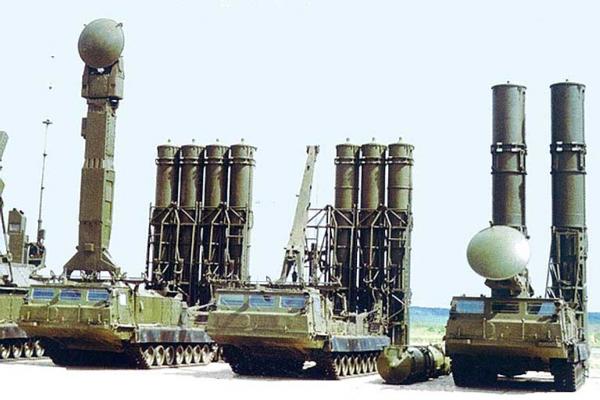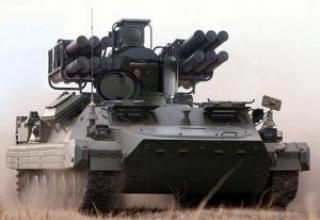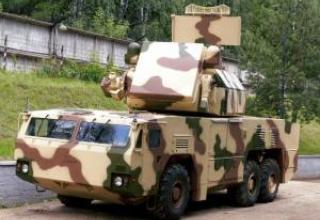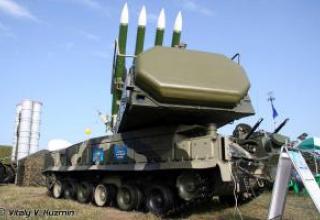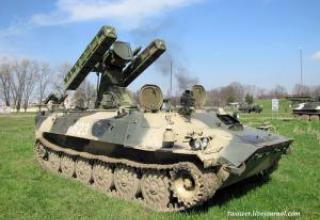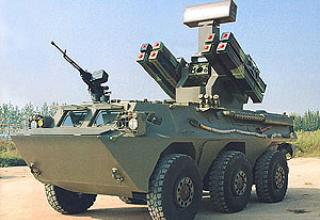The S-300V (9K81) SAM system is designed to protect groups of troops and the most important objects of the front and rear from massive strikes of operational-tactical ballistic missiles (such as "Lance", "Pershing"), aeroballistic missiles (such as SRAM) and cruise missiles (such as ALCM), strategic and tactical aircraft, barrage operators of active interference, combat helicopters in difficult air and interfering environment, while conducting maneuverable combat operations. The S-300V SAM is the first mobile universal missile and air defence system.
The head designer of the S-300V is the Electromechanical Research Institute (NEMI) (Chief Designer V.P. Efremov).
Joint testing of the system was carried out at the Emba Range of the GRAU MO in 1985-1986. The complete set of S-300V SAM systems was adopted for service with the Army Air Defense Forces in 1988. Front-line anti-aircraft missile brigades S-300V was designed to replace the army anti-aircraft missile brigades 2K11 "Krug".
The high combat capabilities and mobility of the S-300V anti-aircraft missile systems have been repeatedly confirmed by training and combat firing and special exercises. For example, in exercises "0boron-92" the system provided for the destruction of aircraft with the first missile, and ballistic missiles were destroyed by it with the consumption of no more than two SAMs.
In the west, the S-300V system was designated SA-12 Giant/Gladiator.
The large upgrade capabilities laid down in the design of S-300V SAMs, allowed for a significant increase in combat capabilities, efficiency and interference immunity of the system. At present, the leading developer of the system, Antey Concern, is offering the S-300VM Antey-2500, the result of a deep upgrade of the S-300V.
The mobile universal anti-missile and anti-aircraft system "Antey-2500" belongs to the new generation of anti-missile and anti-aircraft defense systems (PRO-PSO). It is intended for defense of important state, military and industrial facilities, groups of troops against ballistic and aerodynamic air attacks. "Antey-2500" - the world's only universal means of missile defense and air defense, capable of effectively fighting both ballistic missiles with launch ranges up to 2500 km, and all kinds of aerodynamic and aeroballistic targets. In S-300VM used new anti-aircraft guided missiles with increased range, the range of developed overloads (up to 30 units) and reduced by half the time of preparation for launch. The radar system was upgraded, which resulted in a significant increase in energy potential. More advanced computing facilities and built-in systems of top linking, navigation and orienteering have been applied, and the combat work algorithms have been optimized.
These and other improvements have doubled the system's maximum range (up to 200 km) compared with S-300B, increased the maximum speed of targets to be destroyed from 3,000 to 4,500 m/s and the range of ballistic missiles to be destroyed, and significantly reduced the system's response time (see comparative diagram for S-300B, S-300BM, Patriot PAC-2 and PAC-3). Full automation of combat operations, high operational reliability and the use of modern means of troubleshooting have determined the minimum number of calculations. The combat vehicles of the complex are able to make long marches on rough terrain and take up positions for firing without any prior preparation.
In March 2015. The Ministry of Defense reported the adoption of a new missile for the anti-aircraft missile system S-300V4 (further development of S-300V/S-300VM) with a range of up to 400 km.
Composition:
The S-300B (S-300BM) is a member of the SAF:
- Command post 9C457 (9C457M)
- Survey-3" 9C15M (9C15M2)
- Ginger Survey Radar 9C19M2
- Multichannel Missile Guidance Station (MSNR) 9C32 (9C32M)
- Launchers:
- 9A83 (9A83M) - with four ZUR 9M83 (9M83M)
- 9A82 (9A82M) - with two ZUR 9M82 (9M82M).
- Starting chargers:
- Technical means:
- Rocket and technical support means (PTO) - AKIPS 9B91, a set of rigging equipment 9T325, transport vehicles.
- Maintenance and repair means (ТО and Р) - maintenance machines (9В868-1, 1Р15, 9В879-1), repair and maintenance machines (9В898-1, 1Р16), group ZIP 9T447-1;
- training means (UTs) - training device 9F88 for training the calculation of ISDR 9C32, dimensional and weight models of ZUR, training and active ZUR.
All combat vehicles S-300V: are placed on the unified self-propelled tracked chassis of high cross-country ability, are equipped with unified means of autonomous power supply, navigation, orientation, topo-fixing, life support, telecode and voice radio and telephone communications, have built-in systems of automated functional control, providing quick search for faulty replacement equipment, equipped with devices for deployment in combat position and coagulation in camping position.
There is also a variant of the system with the placement of combat vehicles on the wheeled chassis of the cross-country chassis BAZ-69096, designated as S-300VMK.
The C-300V anti-aircraft missile division consists of 9C457, 9C15M, 9C19M2 radars and four anti-aircraft missile batteries, each of which included one 9C32 multi-channel missile guidance station, two 9A82 multiplexes, one 9A84 launcher, four 9A83 launchers and two 9A85 launchers.
In the mode of centralized control of S-300V SAMs worked on commands, target distribution and target designation from the KP (ASU "Polyana-D4") of the anti-aircraft missile brigade, which was organized into an anti-aircraft missile division (SAM), armed with the system S-300V. The brigade was supposed to have an automated control system (combat control station) consisting of the said ASU with a radar post (which included a 9C15M round-the-clock radar, a 9C19M2 program view radar, a 1L13 duty mode radar and a PORI-P1 radar information processing station, and three or four anti-aircraft missile divisions.
The SAMs are launched from a vertically positioned combustion engine with the pressure of a gunpowder pressure accumulator located in the engine room. After the missile leaves the industrial complex with the help of an impulse engine, the process of declination of the SAM begins at a given angle, which is completed by the time the launch stage is over. At launches to the far zone for aerodynamic purposes the launch of the marching stage engine is performed with a delay of up to 20 seconds in relation to the moment of the end of the launch stage engine operation.
Control of the rocket on the marching and passive flight areas is carried out by deviation of aerodynamic rudders. ZUR is aimed at the target either by the system of inertial control by the method of proportional navigation with the transition to homing approximately 10 s before the flight to the target, or by the system of command-inertial control with homing during the last 3 from the flight. The latter method is used when shooting at targets under conditions of powerful relayed (response) interference of the external cover. The ZUR flight under inertial control is carried out by energetically optimal trajectories, which provides an extremely long range of flight.
The flight task is entered into the airborne LSD computer with a special computer of the launcher and is corrected in flight by radio commands received by the homing equipment from the PU transmitter. The optimal transition to homing is carried out based on information from the homing equipment and the inertial control system of the 9M82 missile, which contributes to the defeat of such small targets as the head part of the Pershing and aircraft SRAM. When firing on the IUNR 9C32 guided missiles, the active interferer in the flight task is entered into the corresponding sign, on which the settings are made to ensure that the missile 9M82 sang at ranges up to 100 km. 0.5-2 s before the rendezvous point for a target on board the SAM system, a team is formed at the beginning of the missile rotation on a roll to ensure maximum coverage of the target by the flow of fragments of the combat unit of the SAM system. 0.3 seconds before the rendezvous point, the non-contact explosive device of the SAM is activated, which gives the command to detonate the BC. In the event of a large miss, the SAM will self-destruct from the BC detonation.
The homing equipment of the LLS has high sensitivity through homing and radiocorrection channels, which allows for reliable capture of the LLS of any target at a range sufficient for rapprochement and engagement. The inertial control system of the LLS provides high accuracy of the missile output to the target acquisition point by the LLS homing equipment.
When the S-300V system operates in stand-alone mode during an aircraft flight and the expected impact of SCUD and Lance type ballistic missiles, the 9C15M radar provides a space overview and provides radar information on detected targets at the system's control room, which in turn determines the necessary modes of operation of this radar. Based on the received data, the control tie the routes of targets, determines the degree of their danger and classes (aerodynamic or ballistic targets), distributes the targets selected for firing to subordinate SAMs (based on their combat readiness, employment and available ammunition of SAMs) and provides target designation of a multi-channel guidance station for missiles.
Upon receiving the target designation, the 9C32NS searches for, detects and hijacks targets designated for firing by car. The capture can be performed automatically or manually (by the station operators). After the start of auto-tracking, the coordinates of these targets are transferred to the control, where they are identified with the routes of targets. The target designation from the control may be with a priority indication of the target being targeted, which means that the target must be hit on a mandatory basis. The control may also give an indication of the IUNR 9C32 for an autonomous search for low-flying targets in sector 1.4° by angle of position and 60° by azimuth. When a low-flying target is detected in this mode, the coordinates of the low-flying targets are received by the control and are identified with its tracks. After capturing the 9C32 ICPD slogan, the SAM commander assigns one of the 9A83 NOs to launch the SAM for the relevant targets. On this command, the transmitter of the target illumination station at the PU is switched on to the equivalent of an antenna. The antenna of the target illumination station is oriented in the direction of the normal to the plane of its PHAR MSNR 9C32, from which the PU begins to receive the target coordinates and their derivatives. Based on the information received, the azimuth and angle of the target location are calculated at the PU to point the antenna of the target illumination station at it, the coordinates of the pre-determined meeting point, the time remaining before the target enters the kill zone and before leaving it, as well as the flight mission for the SAM. The MNSR issues commands to prepare one or two 9M83 SSDs. The results of the solution of the task about the meeting points are initiated on the scoreboard of the commander of the PU.
When the preemptive point is in the kill zone, a launch permit is issued for the SAM and the SAM commander authorises it by issuing a command to the PA to fire (one missile or a sequential salvo of two SAMs). Upon completion of these operations, the "Launch" button is pressed on the SEU, after which the flight mission and the firing plane are memorized on board the SAM system. One or two SSDs will be launched sequentially from the PIC.
In the course of the above operations, a report on the completion of the preparation of the SAMs, the solution of the problem about the meeting point, confirmation of command reception, the firing, and the missile launch are transmitted to 9C32.
According to the command, the transmitter of the target illumination station is transferred to the mode of radiation into space through the horn antenna with a wide beam. According to the information from MSNR 9C32 on target manoeuvres developed at the PU radio commands are corrected flight assignment of LSD. At approaching the LLS to the slot, the light transmitter switches to the parabolic antenna and irradiates the target with a continuous narrow beam for automatic capture and tracking of the target at a speed of approach (Doppler frequency) by the missile's homing equipment. According to the coordinates of the target transmitted on board the ZMD via radio-correction channel and its own coordinates calculated on board the ZMD based on the data of the inertial control system, the moment of the ZMD turning on the roll is determined. The angle of this rotation, which ensures that the target is covered by the directed flow of the WSSD fragments, is calculated using information from the homing equipment. This information is also used for the final launch of a non-contact detonator, a semi-active radio detonator. After that the control of the SAM is stopped and the radio detonator determines the moment of BC explosion of the missile.
After the SAM meets, a command is sent from IUNR 9C32 to the SEU for its discharge. The transmitter switches to the equivalent of an antenna. At the control room of the system with IUNR 9C32, the release of the booster and the remaining SAM system for further target distribution and the issuance of target designation to the SAM system is reported.
When the system is operating in standalone mode, pending the impact of Pershing type ballistic missiles, the 9C19M2 program radar regularly searches for missile threats in 90° sector, azimuth and 26° to 75° angle. If marks appear in any direction in its surroundings, an additional inspection with the beam reversal will be organized. If the obtained marks meet the criterion of tying the trails, the target will be escorted and its trajectory parameters will be given to the system control. The control identifies this information with data from other sources, displays it on the indicators of the reconnaissance and detection post and performs an unscheduled automatic target distribution. When selecting an unoccupied SAM system that was given target designation for firing a target, its position relative to the calculated point of impact of the ballistic missile head unit, mode of operation (for aerodynamic targets or ballistic missiles), and availability of combat-ready firing channels with 9M82 SAMs are taken into account. The ICNR 9C32, which has adopted ballistic missile target designation, automatically searches for a target in the target designation sector and assigns two 9A82 APs to fire this target with the preparation of two 9M82s on each of them or the attached 9A84 launcher.
When a target is detected, the 9C32 IUNR takes the target to a vehicle escort and, if the target coordinates match the target designation, issues a report to the control where it also identifies the target. When the 9C32 is received by a PU from an IUNR, the commander of the PU launches one or two SAMs. Since the ballistic missile head could have been dressed as a decoy, the control team selects the head unit, and the firing is organized against the target with its corresponding sign.
In the event of a threat of enemy aircraft using small-size aircraft missiles such as SRAM, the radar 9C19M2 conducts a regular review of the space in the sector 60° by azimuth and from 9° to 50° by the angle of the place in the direction of the expected raid. The detection and laying of tracks for these targets is carried out in the same way as for Pershing type missiles, but at the system's control room the tracks and markings of only those targets whose speed exceeds 300 ms are issued from the station. Missiles are detected at the control room and the SAMs for which they are most effective are selected. Airborne missiles can be fired against airborne ballistic missiles that were in the airborne target operating mode but have 9M82 air defense systems.
When operating at ranges of up to 100 km, the system's active interfering aircraft operators receive 9C32 target designation from the 9C19M2 radar or the 9C15M round-scan radar from the system's control room or from a higher command post of the S-300V anti-aircraft missile brigade. In this case, the 9C32 takes the aircraft interferer with the vehicle tracking at angular coordinates and reports this to the control system, which gives this station information about the distance to the interference driver, using the data on the distance to the target closest to the direction of the aircraft. At IUNR 9C32, by extrapolating the control data, the distance to the operator is determined. Further operation of the system is carried out in the same way as for conventional aerodynamic targets. At the PU 9A82 all commands necessary for the organization of firing by 9M82 missile are issued, as well as the command with a sign of interference, which is broadcast in the flight task of the LSD and changes the solution of pre-launch guidance of the IUNR 9C32 in accordance with the current coordinates of the target. On board the LRBM, this command alters the algorithm of the on-board computer unit, which ensures the self-guiding of the missile to the target at long distances between them. Otherwise, the system's operation is similar to firing a conventional aerodynamic target.
In the mode of centralized control of S-300V anti-aircraft missile brigade, which is organizationally reduced to an anti-aircraft missile divisions armed with the S-300V system. The brigade has an automated control unit (combat control station) of the said ACS with a radar post (including radar 9C15M, radar 9C19M2, duty mode radar and radar information processing station, three or four anti-aircraft missile divisions.
Each anti-aircraft missile division consists of 9C15M radar, 9C19M2 radar and four anti-aircraft missile batteries, each of which included one 9C32 ICNR, two 9A82 boosters, one 9A84 missile launcher, four 9A83 boosters and two 9A85 boosters.
Characteristics:
| Name | С-300V | С-300VМ |
| Aerodynamic target area, km - at a distance - in height |
up to 100 0.025-30 |
up to 200 0.025-30 |
| Ballistic target acquisition area, km. - at a distance - in height |
up to 40 1-25 |
up to 40 1-30 |
| Maximum target speed, m/sec. | 3000 | 4500 |
| Damage to ballistic missiles launched from a distance, km. | 1100 | 2500 |
| Number of targets simultaneously fired on by the division | 24 | 24 |
| The number of SSDs simultaneously guided by the division | 48 | 48 |
| Rate of fire from a single PU, sec | 1.5 | 1.5 |
| Preparation time for launch of the ZUR, sec | 15 | 7.5 |
| Time of system transfer from duty to combat, sec | 40 | 40 |
| Division ZUR kit | 96-192 | 144 |
| Probability of hitting a target like - BR "Lance" one ZUR 9M83 - One ZUR 9M83. - Pershing missile head unit of one 9M82 missile. - SRAM single launch vehicle 9M82 |
0.5-0.65 0.7-0.9 0.4-0.6 0.5-0.7 |
- - - - |
Testing:
The first combat use of the S-200 SAM system took place in 1982 in Syria, where at a distance of 190 km the E-2C "Hawkeye" DRLO was shot down, after which the American aircraft carrier fleet withdrew from the Lebanese coast. The Libyan S-200 complexes took part in repulsing an attack by American FB-111 bombers and possibly shot down one bomber.
On the basis of the 5B28 anti-aircraft missile of the S-200B complex a hypersonic flying laboratory "Cold" has been created to test hypersonic direct-flow air jet engines. The choice of this missile was based on the fact that the parameters of its flight path were close to those required for flight tests of the Hyper-Sonic Propulsion System. It was also considered important that the missile had been decommissioned and its cost was low. The missile's combat unit was replaced by the head compartments of the GLL "Kholod", which housed the flight control system, a liquid hydrogen tank with displacement system, a hydrogen flow control system with measuring devices and, finally, the experimental HPVRD E-57 of axially symmetric configuration.
Sources:
- С. Петухов, И. Шестаков, Р. Ангельский. "Зенитные ракетные комплексы противовоздушной обороны сухопутных войск". Техника и вооружение №5-6, 1999 г.
- С. Ганин, А. Карпенко, В. Жизневский, Г.Федоров . "Зенитная ракетная система С-300". Невский бастион №3, 1997 г.
- С.Н. Ельцин "Зенитная ракетная система С-300В. Ракета 9М83, устройство и функционирование". Учебное пособие, БГТУ Военмех, 2008г.
